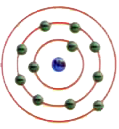What is nucleus of an atom ? Compare its size with that of the atom. Name its constitutents. How is the number of these constituents determined by the atomic number and mass number of the atom ?
Step-by-Step Solution:
1. Definition of Nucleus:
The nucleus of an atom is the central core that contains most of the atom's mass. It is composed of protons and neutrons, which are collectively known as nucleons.
2. Size Comparison:
The size of the nucleus is approximately 10−15 meters (1 femtometer), while the size of an atom is about 10−10 meters (1 angstrom). This means that the nucleus is much smaller than the atom, specifically about 105 times smaller.
3. Constituents of the Nucleus:
The nucleus consists of two types of particles:
- Protons: Positively charged particles.
- Neutrons: Neutral particles (no charge).
4. Determining the Number of Constituents:
- The atomic number (Z) represents the number of protons in the nucleus. This determines the element and its chemical properties.
- The mass number (A) is the total number of protons and neutrons in the nucleus. It can be expressed as:
A=Z+N
where N is the number of neutrons. Therefore, the number of neutrons can be calculated as:
N=A−Z
Summary:
- The nucleus is the dense center of an atom made up of protons and neutrons.
- The nucleus is significantly smaller than the atom, with a size ratio of about 105.
- The atomic number indicates the number of protons, while the mass number indicates the total number of protons and neutrons.
The nucleus of an atom is the central core that contains most of the atom's mass. It is composed of protons and neutrons, which are collectively known as nucleons.
The size of the nucleus is approximately 10−15 meters (1 femtometer), while the size of an atom is about 10−10 meters (1 angstrom). This means that the nucleus is much smaller than the atom, specifically about 105 times smaller.
The nucleus consists of two types of particles:
- Protons: Positively charged particles.
- Neutrons: Neutral particles (no charge).
- The atomic number (Z) represents the number of protons in the nucleus. This determines the element and its chemical properties.
- The mass number (A) is the total number of protons and neutrons in the nucleus. It can be expressed as:
A=Z+N
where N is the number of neutrons. Therefore, the number of neutrons can be calculated as:
N=A−Z
- The nucleus is the dense center of an atom made up of protons and neutrons.
- The nucleus is significantly smaller than the atom, with a size ratio of about 105.
- The atomic number indicates the number of protons, while the mass number indicates the total number of protons and neutrons.
Topper's Solved these Questions
- RADIOACTIVITYBOOK - ICSECHAPTER - RADIOACTIVITYEXERCISE - MULTIPLE CHOICE TYPE
6 Videos
- RADIOACTIVITYBOOK - ICSECHAPTER - RADIOACTIVITYEXERCISE - EXERCISE-12(B)
19 Videos
- RADIOACTIVITYBOOK - ICSECHAPTER - RADIOACTIVITYEXERCISE - NUMERICALS
2 Videos
- QUESTION PAPER-2019BOOK - ICSECHAPTER - QUESTION PAPER-2019EXERCISE - SECTION-II
42 Videos
- REFRACTION OF LIGHTBOOK - ICSECHAPTER - REFRACTION OF LIGHTEXERCISE - DIAGRAM BASED MCQ:
5 Videos
Similar Questions
Knowledge Check
If the mass number of an element is W and its atomic number is N, then
Anumber of 0−1e=W−NBnumber of 11H=W−NCnumber of 10e=W−NDnumber of 10n=NWhat is the name and symbol of the element with atomic number 112?
AUnunbium,UubBUnnibium,UnbCUnunnillum,UunDUnuntrium,Uut
How are the atomic number (Z) and mass number (A) related to each other?
View Solution
What is its atomic number and valency?
View SolutionAtom with the same atomic number and different mass numbers are called
View SolutionNucleus of an atom whose mass number is 24 consists of
View SolutionThe atom of an element is made up of 4 protons, 5 neutrons and 4 electrons. What are its atomic number and mass number?
View SolutionHow many electrons, protons, and neutrons are there in an atom of atomic number 11 and mass number 24?
View Solution
